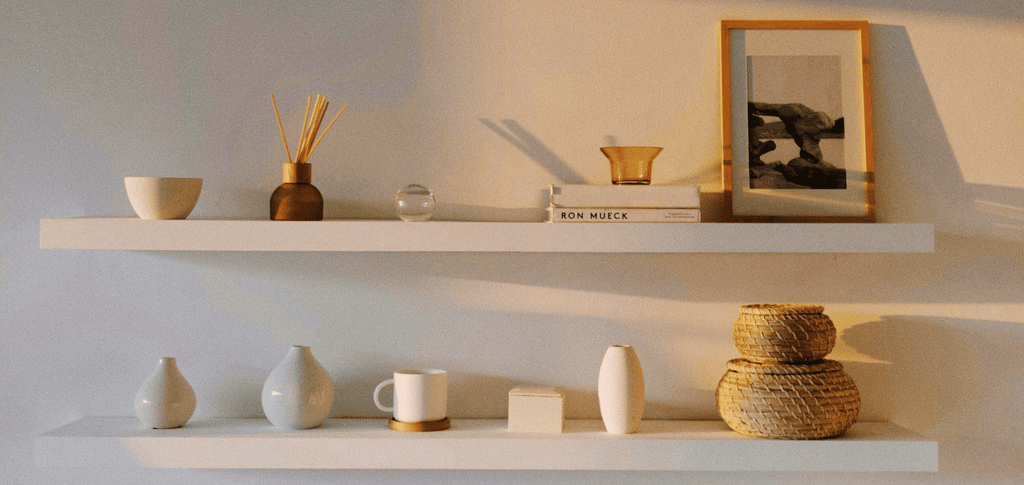5 Ways to Style Open Shelves Like a Designer for a Chic and Organized Home
4/23/20253 min read


Styling open shelves effectively requires balancing aesthetics with functionality. The key to styling shelves like a designer is grouping items thoughtfully, incorporating varied heights and textures, and leaving enough negative space to avoid clutter. This approach creates a clean, curated look that feels intentional rather than overcrowded.
Designers often recommend mixing personal items with decorative pieces, such as plants, books, and art objects, to tell a story while maintaining visual interest. Using shelves to showcase frequently used or meaningful items can also add both style and practicality to any room.
Combining natural materials like wood or stone with metal or glass accents adds contrast and depth. Understanding these simple design principles helps open shelves transform from basic storage into a focal point that enhances the entire space.
Foundational Principles for Styling Open Shelves
Successful open shelf styling hinges on selecting a unified color scheme and balancing practical use with visual appeal. These elements ensure shelves look intentional rather than cluttered.
1. Choosing a Cohesive Color Palette
Selecting a consistent color palette creates harmony on open shelves. Neutral tones such as whites, grays, and beiges often serve as a reliable base. Adding two or three accent colors ties different items together visually.
Grouping similar colors or finishes reduces visual chaos. For example, pairing natural wood with soft earth tones brings warmth. Metallic or glass elements can introduce subtle contrast without overwhelming the space.
It is helpful to consider the surrounding room’s color scheme so the shelves integrate smoothly. Avoid overly bright or clashing colors that draw too much attention away from the overall design.
2. Balancing Functionality With Aesthetics
Effective shelf styling prioritizes both utility and appearance. Frequently used items should be placed within easy reach, typically on lower or middle shelves.
Less-used or decorative pieces belong on higher shelves or areas reserved for display. This separation enhances accessibility and keeps the space practical.
Leaving negative space between items prevents overcrowding and helps the eye rest. Grouping objects by size or type, such as stacking books or clustering vases, creates order.
Combining personal items with functional objects maintains an authentic feel while avoiding messiness. This balance keeps shelves looking curated yet useful.
Design Techniques for Curating Open Shelving
Effective open shelf styling involves balancing shapes, textures, and personal elements. Attention to arrangement and the use of functional yet decorative items can create a cohesive and attractive display.
3. Incorporating Varied Heights and Textures
Varying the height of objects adds visual interest and prevents the shelves from appearing flat or monotonous. Group taller items like vases or books with shorter pieces such as small sculptures or stacked boxes to create layers.
Combining different materials—wood, metal, glass, or ceramics—brings texture contrast that enriches the overall look. Soft textiles like folded linens can also add warmth.
Using asymmetry in height and texture avoids stiffness while maintaining harmony when objects are thoughtfully spaced with some negative space around them.
4. Showcasing Art and Personal Touches
Artwork and personal items make open shelving feel curated rather than random. Small framed prints, postcards, or photographs can be leaned against the wall or interspersed among decor.
Adding unique pieces that reflect personality, such as travel souvenirs or heirlooms, adds character and interest. These items should be grouped deliberately to avoid clutter.
Display a limited number of personal objects to maintain balance, alternating these with neutral or decorative pieces to ensure the shelf doesn’t feel overcrowded.
5. Utilizing Decorative Containers and Baskets
Decorative containers and baskets are practical for organizing loose items while enhancing style. Choose containers that complement the shelf's design, such as woven baskets for natural texture or metal tins for an industrial feel.
Labels or uniform containers can keep the look neat, especially on kitchen or office shelves. Containers also help reduce visual clutter by concealing smaller objects.
Grouping containers in sets or pairing them with open items balances functionality with aesthetics, making shelves both useful and visually appealing.